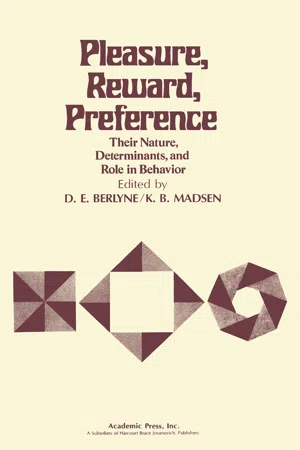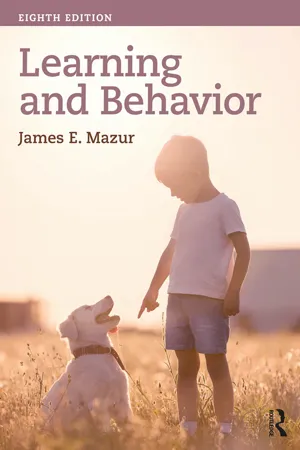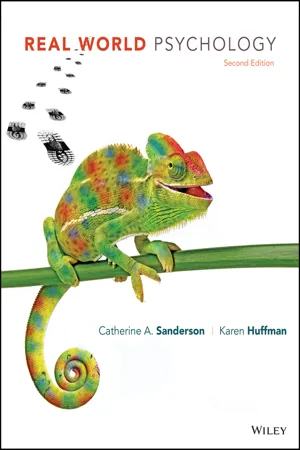Psychology
The Law of Effect
The Law of Effect, proposed by psychologist Edward Thorndike, states that behaviors followed by positive consequences are more likely to be repeated, while behaviors followed by negative consequences are less likely to be repeated. This principle forms the basis of operant conditioning and has been influential in understanding how behaviors are shaped and maintained.
Written by Perlego with AI-assistance
Related key terms
1 of 5
6 Key excerpts on "The Law of Effect"
- eBook - PDF
Pleasure, Reward, Preference
Their Nature, Determinants, and Role in Behavior
- D. E. Berlyne, K. B. Madsen, D. E. Berlyne, K. B. Madsen(Authors)
- 2013(Publication Date)
- Academic Press(Publisher)
CHAPTER 6 Personality and The Law of Effect H. J. EYSENCK University of London In some form or other, The Law of Effect has been one of the most widely recognized generalizations in the whole of psychology. The belief that rewards and punishments are powerful tools for the selec-tion and fixation of desirable acts and the elimination of undesirable ones (Postman, 1947) is almost universal, and although the law itself is usually associated with the name of Thorndike (1911) who first used this phrase, he had precursors, e.g., Bain (1868) and Spencer (1870), who brought together the contributions of Associationism, Hedonism, and Evolutionary Doctrine in a coherent form closely resembling Thorndike's own formulation. This formulation was as follows: Of several responses made to the same situation, those which are accom-panied or closely followed by satisfaction to the animal will, other things being equal, be more firmly connected with the situation, so that when it returns, they will be more likely to recur; those which are accompanied or closely followed by discomfort to the animal will, other things being equal, have their connection with the situation weakened so that, when it recurs, they will be less likely to occur. The greater the satisfaction or discomfort the greater the strengthening or weakening of the bond [Thorndike, 1911, p. 244]. In this statement, Thorndike appears to have abandoned the Spencer-Bain tradition of frankly invoking pleasure and pain as agents responsi-ble for the fixation and elimination of responses; as Postman (1947) put 133 134 H. J . EYSENCK it, Thorndike's law has been a law of effect, not affect, [p. 496] By defining satisfiers and annoyers independently of subjective experience and report, he seems to have abandoned hedonism; in his own words, By a satisfying state of affairs is meant one which the animal does noth-ing to avoid, often doing such things as to attain and preserve it. - eBook - PDF
Schedule Effects
Drugs, Drinking, and Aggression
- R. M. Gilbert, J. D. Keehn(Authors)
- 2019(Publication Date)
- University of Toronto Press(Publisher)
4 Schedule-dependence, schedule-induction, and The Law of Effect J. D. KEEHN OPERANT BEHAVIOUR AND The Law of Effect Although the definition and analysis of opérant behaviour is recent (Skinner, 1938), the province of behaviour so called has existed in the name of voluntary actions for ages. It was Thorndike who released this class of behaviour from the whim of a capricious will and placed it in bondage on the authority of The Law of Effect. The Law of Effect thereby mechanized behaviour once thought to be free, although it is clearer now that it is not mechanization but orderliness in behaviour that the law has brought to light. It is worth examining the current sta-tus of The Law of Effect, some limits to its powers in bringing behaviour to order, and some signs of order in voluntary behaviour that seem to be outside the province of the law. The role of The Law of Effect in sustaining a paradigm shift in psycho-logical science in the sense explained by Kuhn (1962) for physical sci-ence has been described elsewhere (Keehn, 1969a). Because of the law, the guiding paradigm of psychological investigation and explanation has been redirected from one that was labelled S-O-R (stimulus-organism-re-sponse) to one that can be summarized S-R-S R (stimulus-response-rein-forcement). The sense of change is apparent in an early formulation of the law (Thorndike, 1911), which begins in an approximation to the language of S-R-S psychology: The Law of Effect is that: of several responses made to the same situa-tion, those which are accompanied or closely followed by satisfaction to the animal will, other things being equal, be more firmly connected with the situation, so that, when it recurs, they will be more likely to recur; those which are accompanied ... by discomfort ... will be less likely to recur ... 66 J.D. Keehn and ends in the purview of S-O-R: The greater the satisfaction or discomfort, the greater the strengthening or weakening of the bond. - eBook - ePub
Great Ideas in Psychology
A Cultural and Historical Introduction
- Fathali M. Moghaddam(Author)
- 2013(Publication Date)
- Oneworld Publications(Publisher)
Two sets of experiments conducted before Watson’s 1913 manifesto came to fundamentally influence the new school of behaviorism. The first was conducted by Thorndike in the late 1890s as part of his doctoral research and involved training cats to escape from a “puzzle box.” Thorndike made a number of puzzle boxes, which required a hungry cat placed inside to break out by pushing a latch or some other similar device. The main motivation for the hungry cat to break free was to eat the food that had been placed within its view outside the box. In the initial period after being placed inside the box, the cats would typically scramble about frantically. After some time, they would accidentally hit the latch that opened the box and then spring to freedom and food. In subsequent trials, there was a gradual improvement in performance, so that eventually the hungry cat would quickly take the correct action to open the puzzle box.On the basis of his experiments, Thorndike proposed the law of effect , which postulates that the likelihood of a behavior being repeated depends on its outcome: behavior with positive outcome is more likely to be repeated, whereas behavior with negative outcome is less likely to be repeated. He also proposed the law of exercise , which simply put states that the more often an association is strengthened, the stronger it will become. In traditional accounts of Thorndike’s research, the implication is that his major contribution is The Law of Effect, and the law of exercise is sometimes also highlighted as important. But neither of these laws originates with Thorndike. Less formal versions of both of these laws have been around for about twenty-five centuries. Thorndike’s contribution is more the empirical justification he put forward for an exclusive focus on observable behavior.Through repeated trials testing animals under controlled conditions, Thorndike concluded that the learning exhibited by the cats could be explained without any reference to consciousness, images, or thought. The animal did not suddenly gain insight into the problem and see the solution. If that had been the case, the learning curve would have shown a sudden shift (reflecting a “Eureka!” experience), whereas it showed a gradual slope, suggesting an incremental strengthening of an association between stimuli and response. Rather than try to imagine what might be going on in a cat’s hypothetical mind, it was far better for researchers to study behavior objectively from the outside. This laid the foundation for the behaviorist movement. - eBook - PDF
Learning Psychology NQF4 SB
TVET FIRST
- N Horn P Huygen(Author)
- 2013(Publication Date)
- Macmillan(Publisher)
Mechanical learning was also discussed. Operant conditioning • : the Laws of Learning as proposed by Thorndike ’ s Laws of Learning and Skinner ’ s theory of Reinforcement, Punishment and Extinction. We saw that Thorndike ’ s Law of Frequency means that we do what we have done often before. We get up in the morning and we brush our teeth and hair and then get dressed. We do this often so we keep on doing it. The Law of Effect states that we repeat behaviours that make us happy. When we have brushed our teeth, our mouths feel fresh and clean. When we have dressed nicely, we feel better and sometimes people even give us compliments. Skinner ’ s theory claims that the consequences of our actions can cause us to repeat the action or not to repeat the action. Reinforcement is a consequence of our actions that will cause us to behave like that again. • Punishment is a consequence that will stop us from behaving like that again or behaving like • that less and less Extinction is when we are ignored – there is no consequence, so if no one is taking notice we will • stop the behaviour We also discussed modelling and how it fits in with other theories of learning. Lastly we discussed informal learning. We found that social learning theories state that: We will learn through watching other people • We can learn in this way without changing our behaviours. Our example above illustrates this: • we learn that when people do well in sport they are admired. However, this does not mean that all of us now want to become athletes, some of us are content just watching Cognition plays a role in our learning: we are aware of the rewards and punishments of learning • certain behaviours and we therefore make our own decisions about our behaviour Social learning can be seen as a link between behaviourist learning theories and cognitive • learning theories. We also found that learning takes place anyway – some learning happens informally. - eBook - ePub
Learning & Behavior
Eighth Edition
- James E. Mazur(Author)
- 2016(Publication Date)
- Routledge(Publisher)
Figure 5.2 The number of seconds required by one cat to escape from a simple puzzle box on 24 consecutive trials. (From Thorndike, 1898)The application of The Law of Effect to the puzzle-box experiments is straightforward: Certain behaviors, those that opened the door, were closely followed by a satisfying state of affairs (escape and food), so when the animal was returned to the same situation it was more likely to produce those behaviors than it had been at first. In modern psychology, the phrase “satisfying state of affairs” has been replaced by the term reinforcer , but The Law of Effect (or the principle of positive reinforcement ) remains as one of the most important concepts of learning theory.Guthrie and Horton: Evidence for a Mechanical Strengthening Process
Two researchers who followed Thorndike, E. R. Guthrie and G. P. Horton (1946), provided more convincing evidence that the learning that took place in the puzzle box involved the strengthening of whatever behavior happened to be followed by escape and food. They placed cats in a puzzle box with a simple solution: A pole in the center of the chamber had only to be tipped in any direction to open the door. A camera outside the chamber photographed the cat at the same instant that the door swung open, thereby providing a permanent record of exactly how the cat had performed the effective response on each trial. The photographs revealed that after a few trials, each cat settled on a particular method of manipulating the pole that was quite consistent from trial to trial. However, different cats developed different styles for moving the pole; for example, one cat would always push the pole with its left forepaw, another would always bite the pole, and another would lie down next to the pole and roll over into it (Figure 5.3 ).In summary, Guthrie and Horton found that after their cats mastered the task, there was relatively little variability from trial to trial for a given cat, but there was considerable variability from one cat to another. These results provide evidence for a particular version of The Law of Effect that Brown and Herrnstein (1975) called the stop-action principle - eBook - PDF
- Catherine A. Sanderson, Karen R. Huffman(Authors)
- 2016(Publication Date)
- Wiley(Publisher)
This was because Skinner believed that the only way to know how we have influenced an organism’s behavior is to check whether it Reinforcement Adding or removing a stimulus following a response increases the likeli- hood that the response will be repeated. Punishment Adding or removing a stimulus following a response decreases the likeli- hood that the response will be repeated. [Q2] Law of effect Thorndike’s rule that any behavior followed by pleasant consequences is likely to be repeated, whereas any behavior followed by unpleas- ant consequences is likely to be stopped. FIGURE 6.6 Thorndike’s law of effect In his most famous experiment, Thorndike put a cat inside a specially built puzzle box. When the cat stepped on a pedal inside the box (at first by chance), the door opened, and the cat could get out and eat. Then, through trial and error, the cat learned what specific actions led to opening the door. With each additional success, the cat’s actions became more purposeful, and it soon learned to open the door immediately (Thorndike, 1898). Operant Conditioning 155 increases or decreases. As he pointed out, we too often think we’re reinforcing or punishing behavior, when we’re actually doing the opposite (see Psychology and You). Clarifying Reinforcement versus Punishment Until now, we’ve only discussed reinforcement and punishment in general terms. But it’s important to clarify exactly how they either increase or decrease behavior. To begin, you need to understand that psychologists group reinforcers into two types, primary and secondary. A primary reinforcer is any unlearned, innate stimulus (like food, water, or sex) that reinforces a response and thus in- creases the probability that it will recur. A secondary reinforcer is any learned stimulus (like money, praise, or attention) that reinforces a response and thus increases the probability that it will recur. The key point is that “primary” is another word for unlearned, whereas “secondary” means learned.
Index pages curate the most relevant extracts from our library of academic textbooks. They’ve been created using an in-house natural language model (NLM), each adding context and meaning to key research topics.





